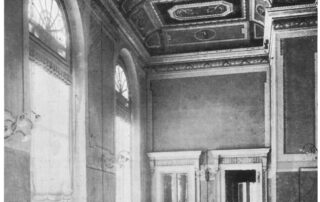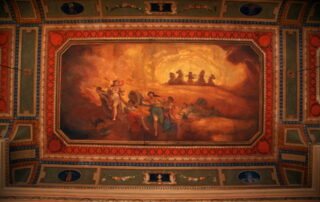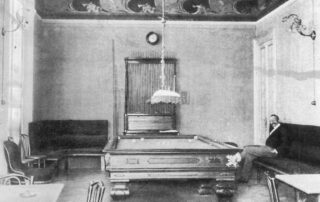Riccardi Hall, dedicated to the man who had built the Theater. This hall wasn’t part of the original structure: for over 100 years, Theater was left without a façade, although there had been frequent talks about a renovation and expansion.
In 1897, Theater celebrated 100 years since Gaetano Donizetti’s birth. It was time for great changes, the whole town was proudly paying tribute the great composer.
The name of the Theater was changed: from Teatro Riccardi became Teatro Donizetti, and according to the plans made two years earlier, it had a new façade, which was completed with a little delay in 1898, together with these new halls. The box owners wanted a space for themselves, and this became the headquarter of the Circolo dell’Unione, the Union Circle. In these new rooms, decorated with frescoes by Achille Filippini Fantoni and Fermo Taragni, the most distinguished people in Bergamo used to gather and chat.
UNION CIRCLE
The rules were quite formal and strict: people came here for pleasure and fun, but everyone had to comply with those rules. To join the circle, two members had to support you. Then there was a ballot, and the ballot box had to display all white balls. If only one ball was black, you were rejected.
Members used to come here to play pool or bridge, but no gambling was allowed. These rooms also featured a library, were new books were ordered every year. There was a fine restaurant and bar service, with waiters whose uniforms were chosen by the members. It was a very friendly environment, but members knew that they had to pay their bills on the same day, or within a few days, or they may be excluded for good. Women, i.e. mothers, spouses and daughters of members, were allowed in only on special occasions, upon receiving a written invitation.
Over the years, the rooms became dark and smokey, but their charm remained unchanged.
The Circle also had four stages that hosted great parties and outstanding artists, such as Mascagni, Toscanini and Giordano.
The Union Circle was mostly active at nights, when members gathered behind the thick curtains of the large windows looking onto the main street. Called Sentierone, this street replaced the old fair building, at the beginning of the 20th century. In the years after World War Two, everybody walked along the Sentierone and Bergamo was a vibrant town, eager to be reconstructed and reborn. The street was full of shops and bars, and occasionally some photographers were seen taking pictures of beautiful girls, cheerful young men and lovely couples who would then buy the photos. The bar tables were filled with intellectuals and well-known businessmen.
In the first half of the 20th century, the Caffè Nazionale was the main place to be: the owner offered good food and great shows, featuring beautiful dancers and musicians. Jazz was often played at the Caffè, to please the American soldiers who had stayed in Bergamo after the war. There are countless stories of jam sessions and concerts that went on all through the night.
Over the years, a number of new bars were opened and the Balzer became the most prominent one. It offered a sophisticated environment and service, to please the bourgeoisie and the noblemen of Bergamo, but also the actresses and actors that were … obviously familiar to the Theater.



